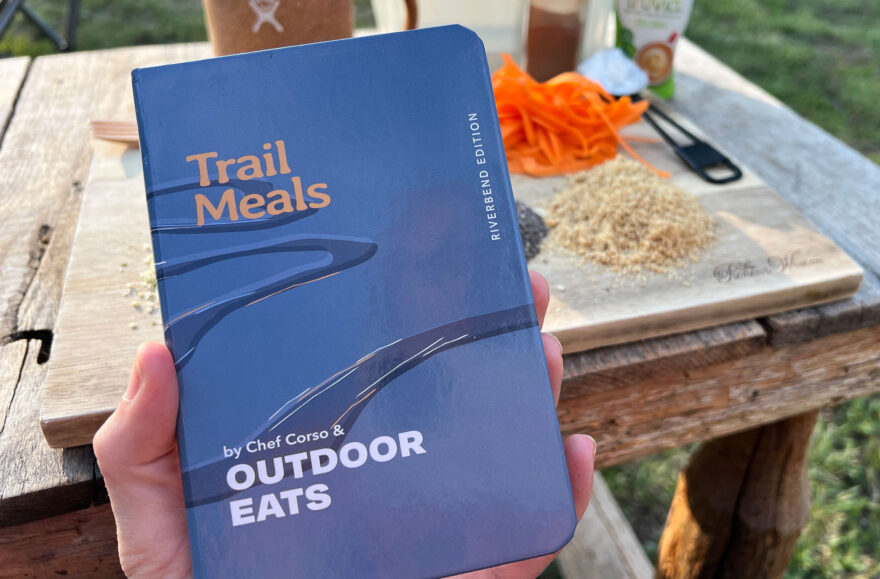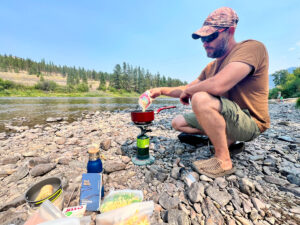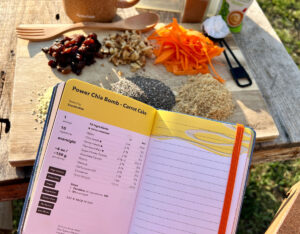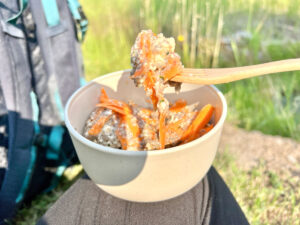
Image by Suzanne Downing
If you’ve ever been on a day hike or a multi-day backcountry trip, staring at yet another dehydrated meal from a foil packet, it might be time to mix it up. Packing and cooking some easy-to-make meals using fresh ingredients is one alternative to eating pre-packed food out on the trail. With a little extra effort — and some guidance from Chef Corso and Outdoor Eats — you can easily elevate your outdoor meals.
We all know that those common pre-packaged and dehydrated camping foods like Mountain House Beef Stroganoff — a popular freeze-dried meal known for convenience and long shelf life — can do the job. But dehydrated meals often lack the richness of freshly prepared ingredients. Other options like Good-To-Go Herbed Mushroom Risotto (a meal from a brand focused on high-quality ingredients), although flavorful and more nutritious than others in their category, can sometimes be overly salty and the texture can be inconsistent, with some ingredients becoming mushy or too chewy after rehydration.

Image by Suzanne Downing
Cooking real food over a portable stove along a trail or at your campsite can give you a much more satisfying and flavorful dining experience. Having fresh ingredients like vegetables, meats, whole-grains and herbs gives you a variety of textures and flavors that just can’t be matched by dehydrated meals.
While cooking over a stove requires more room in your pack and more effort and planning — like gathering fresh ingredients, a stove and cookware — the payoff is a meal that feels more rewarding and nourishing. It also offers you an opportunity to customize meals to your taste, adjusting seasoning and ingredients to what you like.
About Chef Corso & Outdoor Eats
Chef Steve Corso — a classically trained chef — is passionate about helping people enjoy the benefits of cooking real ingredients outdoors. He launched Outdoor Eats in 2019 with a mission to revolutionize outdoor cooking. He also has a successful cooking series on YouTube.
His journey started during backpacking trips through the North Cascades National Park in Washington state, where he recognized the need for better, more satisfying camp meals.
Through Outdoor Eats, Corso offers e-guides and pocket-sized recipe books. To make these recipes you’ll need just 10 ingredients or less, and Corso designed each recipe to take you less than 30 minutes to prepare outside.
The disappointment of bland hiking meals prompted Corso to bring his culinary expertise to the trail. With more than a decade in the culinary arts, including culinary school in Northern Italy and Napa Valley, experience as a head chef, research chef roles in test kitchens and training culinary teams worldwide, Corso used his experience to launch his brand.
Below are three recipes I tested from the Outdoor Eats’ Trail Meals Riverbend Edition recipe book (which fits in my hand). The most time consuming part of these meals was shopping for the ingredients. Once the ingredients were in hand, the rest of the work was easy, fun and rewarding.
Below you’ll discover the ingredients for each recipe, learn about the process and see the final meal come together.
Breakfast: Power Chia Bomb — Carrot Cake
As a fan of carrot cake, this recipe seemed like a good fit. Since I was going on a day hike, I decided to prepare this meal outside by a creek in my home state of Montana the day before and let it sit overnight to take with me and enjoy first thing in the morning. That’s one of the beauty of these outdoor meal recipes, you can tailor them to fit your unique schedule and lifestyle.

Image by Suzanne Downing
10 Ingredients:
Water (6 oz.)
Chia Seeds (2 Tbsp)
Hemp Hearts (2 Tbsp)
Flax Seed Meal (2 Tbsp)
Sugar/Honey Packets (2 Tbsp)
Shredded Carrots (2 Tbsp)
Raisins (2 Tbsp)
Walnuts (2 Tbsp)
Oil/Coconut Oil (1 Tbsp)
Cinnamon (1 tsp)
Steps:
1. Gather all 10 ingredients and measure them out.
2. Combine all of the ingredients and stir. (I used a silicone bag.)
3. Leave it to sit overnight.
4. Enjoy a nutritional and tasty breakfast.

Image by Suzanne Downing
Final meal and thoughts:
It took about five minutes to measure and combine the ingredients into the bag. After sitting overnight, this breakfast tasted hearty and sweet. The walnuts added a crunch, while the cinnamon and raisins brought a touch of sweetness. And although it’s made for one serving, I found it can easily feed two people. I added double the amount of shredded carrots than the recipe called for to add in some extra veggies. When I make this recipe again, I’ll tone down the carrots as it was a little overpowering. (Chef Corso knows best!)
Overall this recipe was tasty and hearty. And after doing some digging, I found that chia seeds, flax seed meal and hemp hearts are rich in omega-3s, fiber and protein, which are all great for giving me energy before heading out to hike.
Dinner: Shepherd’s Pie Bowl
This meal seemed like a good one to test from Corso’s “Classics Elevated” category. I like a hearty meal at the end of a day hiking, and making this meal down by the Clark Fork River in Montana seemed like a great pairing. The recipe is from the Riverbend Edition so it was fitting.

Image by Suzanne Downing
10 Ingredients:
Fake Meat, your fav (10 oz.)
Garlic/Garlic Powder (2 cloves, ½ tsp)
Olive Oil (2 Tbsp)
Beef Bouillon Cube (1)
Fresh or Frozen Peas (4 oz)
Fresh or Frozen Corn (4 oz)
Salt (to taste)
Water (20 oz)
Instant Mashed Potatoes (2 pkg)
Cheese Grated (optional) (4 oz)
Steps:
1. Lay out all the ingredients and get the portable camp stove ready.
2. Boil 16 oz of water, add potatoes and set aside
3. Chop garlic while the potatoes cook.
4. Add oil, garlic, bouillon cube and meat and cook for 5 minutes adding a pinch of salt.
5. Add peas and corn and cook for 5 more minutes.
6. Add the meat and veggies to a bowl and top with cheese.
7. Add the mashed potatoes on top.

Image by Suzanne Downing
Final meal and thoughts:
This meal was so flavorful. I used pre-cooked turkey meat and packaged it between the frozen peas and corn to keep it fresh in my backpack, sort of like a cooler. The instant potatoes were very easy to make and the whole meal came together in less than 30 minutes. The peas and carrots added some crunch, and the oil and garlic gave the meal some depth.
I’ll be making this again for sure, and I feel like this is an easy meal you can make over and over. I wouldn’t recommend eating it for lunch if you have more hiking to do as it’s very filling. It’s perfect for an end-of-the-day meal.
Dessert: Trail Tiramisu
With a sweet tooth and a love for coffee, this dessert was an obvious choice from Corso’s Riverbend Edition recipe book. If you’re not a fan of coffee, you may want to skip this one (or omit the coffee) as it has a strong coffee taste. I substituted Lady Fingers for Milano Milk Chocolate Cookies since our local grocery store didn’t offer them, so the version I tested had more chocolate in it. I also like the name Chef Corso chose: Trail Tiramisu. While eating this dessert, I liked the contrast of eating a fancy restaurant dessert in a rugged setting.

Image by Suzanne Downing
5 Ingredients:
Nesquik/Chocolate Milk Mix (2 Tbsp)
Water (8-10 oz)
White Chocolate or French Vanilla Instant Pudding (1.8 oz)
Instant Coffee (1 packet)
Lady Fingers (4-6)
Steps:
1. Gather all the ingredients and boil 4 oz of water.
2. Pour in your coffee and chocolate mix, stir and turn off heat.
3. In a bowl, mix pudding mix with 5-6 oz of water until set.
4. Dip 4 cookies in the coffee/chocolate water mix until coated and place in individual bowls.
5. Top with pudding and crumble 1 additional cookie on each.

Image by Suzanne Downing
Final meal and thoughts:
If I had to rate this dessert on a reality TV show I’d give this an 11 out of 10. It was so rich and flavorful using the Milano chocolate cookies paired with the white chocolate pudding mix. I also used a bold coffee blend so that gave it a robust coffee flavor. This will be a trail dessert staple as it was easy to make and would be a welcome treat after a long day of hiking.

Image by Suzanne Downing
The next time you head into the wild, consider leaving the granola bars and dehydrated meals at home, or at least swapping one meal a day from Chef Corso’s collection. If all of the recipes are as good as these three random picks, you’re in for a wonderful dining experience.
Suzanne Downing is an outdoor writer and photographer in Montana with an environmental science journalism background. Her work can be found in Outdoors Unlimited, Bugle Magazine, Missoulian, Byline Magazine, Communique, MTPR online, UM Native News, National Wildlife Federation campaigns and more.
 Your Privacy Choices
Your Privacy Choices